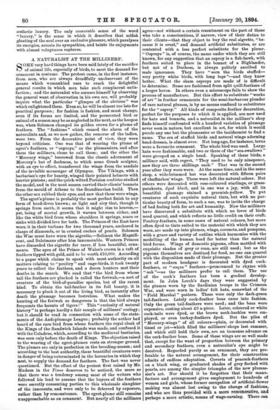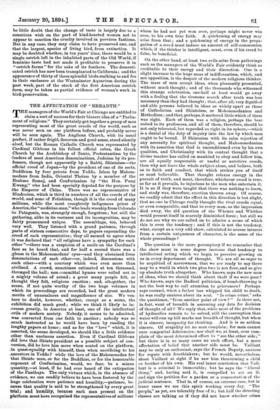A NATURALIST AT THE MILLINERS'.
SOME very hard things have been said lately of the sacrifice of animal life, especially of birds, to meet the demand for ornament in costume. The protest came, in the first instance, from men, who are always dreadfully unobservant of the means which womankind uses to reach the delightful general results in which men take such complacent satis- faction ; and the naturalist who amuses himself by observing the general want of observation in his own sex, will probably inquire what the particular "glimpse of the obvious" was which enlightened them. Even so, he will be almost too late for practical purposes ; for fashion is fashion, and must change, even if its forms are limited, and the persecuted bird or animal of a season may be as neglected in the next, as the hoopoe was, when Solomon changed its golden crown for a plume of feathers. The " fashions " which roused the alarm of the naturalists and, as we now gather, the remorse of the ladies, were two. From the decorative point of view, they were beyond criticism. One was that of wearing the plume of egret's feathers, or "ospreys," as the plumassiers, and after them the milliners, chose to call them; and the other the "Mercury wings," borrowed from the classic adornment of Mercury's hat of darkness, to which some Greek sculptor, with an eye to effect, transferred the wings from the sandals of the invisible messenger of Olympus. The Vikings, with a barbarian's eye for beauty, winged their pointed helmets with heavier pinions ; and the quick-witted Parisian modistes studied the model, and in the next season carried their clients' bonnets from the mould of Athens to the Scandinavian build. Then the other sex rubbed their eyes, and saw that these were wings.
The egret's plume is probably the most perfect finish to any form of head-dress known ; so light and airy that, though it springs from earth, it seems that it might rise to heaven,— yet, being of mortal growth, it wavers between either, and like the white bird from whose shoulders it springs, soars or sinks with divided love for both. The Princes of the East have worn it in their turbans for two thousand years, anchored in clasps of diamonds, or in crusted ouches of pearls. Solomon the Wise must have worn the aigrette,—Soliman the Magnifi- cent, and Suleimans after him innumerable. Western Princes have discarded the aigrette for rarer, if less beautiful, orna- ments. The apex of the Prince of Wales's crown is a tuft of feathers tipped with gold, said to be worth £10,000. According to a paper which claims to speak with most authority on all matters relating to " poultry " and cage-birds, it took twenty years to collect the feathers, and a dozen hunters met their deaths in the search. We read that "the bird from whose tail the feathers are plucked is called the feriwah,—a sort of creature of the bird-of-paradise species, but of the rarest kind. To obtain the tail-feather in its full beauty, it is necessary to pluck it out of the living bird, as instantly after death the plumage becomes lustreless. What makes the hunting of the feriwah so dangerous is that the bird always frequents the haunts of tigers !" This "curiosity of natural history " is perhaps hardly a fair sample of milliners' zoology; bat it should be read in connection with some of the state- ments of the Anti-plumage League ; probably the author bad heard of the rare bird from whose feathers the royal cloak of the Kings of the Sandwich Islands was made, and confused it with the Caladrus, which, according to the mediwval bestiaries, was seen only before the death of Kings. The objection raised to the wearing of the egret-plumes rests on stronger ground. The plumes are only in perfection in the breeding-season; and according to the best authority, these beautiful creatures were in danger of being exterminated in the heronries in which they nest, to supply the demand for feathers. The fact was never questioned. But the effect of the protest first raised by Mr. Hudson in the Times deserves to be noticed, the more so that there was a tendency among most of the writers who followed his lead to assume that the buyers of the feathers were secretly consenting parties to this wholesale slaughter of the innocents, and were only to be deterred by exposure, rather than by remonstrance. The egret-plume still remains unapproachable as an ornament. But nearly all the milliners agree—not without a certain resentment on the part of those who take a conscientious, if narrow, view of their duties to their clients—that they object to buy the real aigrette, "be- cause it is cruel," and demand artificial substitutes, or are contented with a less perfect substitute for the plume. " Ospreys " is, of course, the name under which they are still known, for any suggestion that an osprey is a fish-hawk, with feathers suited to place in the bonnet of a Highlander, but not of a Duchess, is always politely ascribed to male ignorance. They have "seen the birds stuffed— very pretty white birds, with long legs "—and they know better. What the sham ospreys are made of is difficult to determine. Some are fashioned from split quill-feathers of a larger heron. In others even a microscope fails to show the process of manufacture. But this effort to substitute "works of art" in feather ornaments for the semi-barbarous plunder of rare natural plumes, is by no means confined to substitutes for the "osprey." All kinds of composite feather decoration, perfect for the purposes to which it is applied, are now used for hats and bonnets, and a naturalist in the milliner's shop finds himself confronted with a hundred varieties of plumage never seen in nature, but excellent in art, for which it would puzzle any one but the plumassier or the taxidermist to find a name. The era of stuffed birds and natural wings adorning head-dresses, is almost over. Not long ago, for instance, terns were a favourite ornament. The whole bird was used. Large hats were fashionable, and two or three of the " sea-swallows" were grouped on a single head. Speaking of these birds, a milliner said, with regret, "They used to be only ninepence, now they are three shillings each." That was in the second year after they were worn. At the same time, and in the same shop, a wide-brimmed hat was decorated with fifteen pairs of chaffinches' wings. These were left the natural colour. But others were decorated with rose-coloured starlings, or grass- parakeets, dyed black, and in one was a jay, with all its beautiful plumage stained a greenish-yellow. To put creatures of such exquisite natural tints, but with no par- ticular beauty of form, to such a use, was to invite the charge of bad feeling both for art and humanity. Now the milliners have discovered a substitute with which no lover of birds need quarrel, and which reflects no little credit on their craft. Poultry-feathers, in some cases of natural colours, but more often dyed to tints suited to the material with which they are worn, are made up into plumes, wings, coronets, and pompons, with a grace and variety of outline which harmonise with the modelling of the human head far better than the natural bird forms. Wings of domestic pigeons, often mottled with exquisite shades of grey or roan, are still used ; but as the pigeons themselves are destined for food, no one can quarrel with the disposition made of their plumage. But the greater part of modern headgear is decorated with dyed cock. feathers, or " coque " feathers—pronounced to rhyme with "oak "—as the milliners prefer to call them. The use of the cock's feathers has been a gradual develop- ment. In John Leech's days they were suggested by the plumes worn by the Sardinian troops in the Crimean War, and were worn in ladies' felt hats, somewhat of the "Field Marshal" pattern. These were only the dark-green tail-feathers. Lately cock-feather boas came into fashion. Only the green tail-feathers were used ; and the boas were expensive, costing about 23 a-piece. Later, coloured or white cock-tails were dyed, or the brown neck-hackles were em- ployed, or even turkey-feathers dyed. But the piles of " Mercury-wings " of all colours—plain, or decorated with tinsel or jet—which filled the milliners'-shops last summer, and which still hold their own, are an immense advance on the cock-feather boas. Some of these wings are so well made that, except for the want of proportion between the primary and secondary feathers, even a naturalist's eye might be deceived. Regarded purely as an ornament, they are pre- ferable to the natural arrangement, for their construction admits of endless adaptation. Coverts of peacock-feathers on a black wing, or graduated shades of grey flecked with pearls, are among the simpler triumphs of the new plamas- sier's art. Nor should it be forgotten that their manu- facture and arrangement gives employment to hundreds of women and girls, whose former occupation of artificial-flower making was almost lost owing to the change of fashions, and who are thus provided with a more remunerative, and perhaps a more artistic, means of wage-earning. There can
be little doubt that the change of taste is largely dire to a conscious wish on the part of kind-hearted women not to appear to sanction the cruelty involved in previous fashions. But in any case, they may claim to have preserved one, and that the largest, species of living bird, from extinction. It may be doubted whether, in ten years' time, there would be a single ostrich left in the inhabited parts of the Old World, if feminine taste had not made it profitable to preserve it in "ostrich farms" for the sake of its feathers. The domesti- cated ostrich has new been transplanted to California; and the appearance of thirty of these splendid birds stalking to and fro in their enclosure at the Westminster Aquarium during the past week, part of the stock of the first American ostrich farm, may be taken as partial evidence of woman's work in bird-preservation.



































 Previous page
Previous page